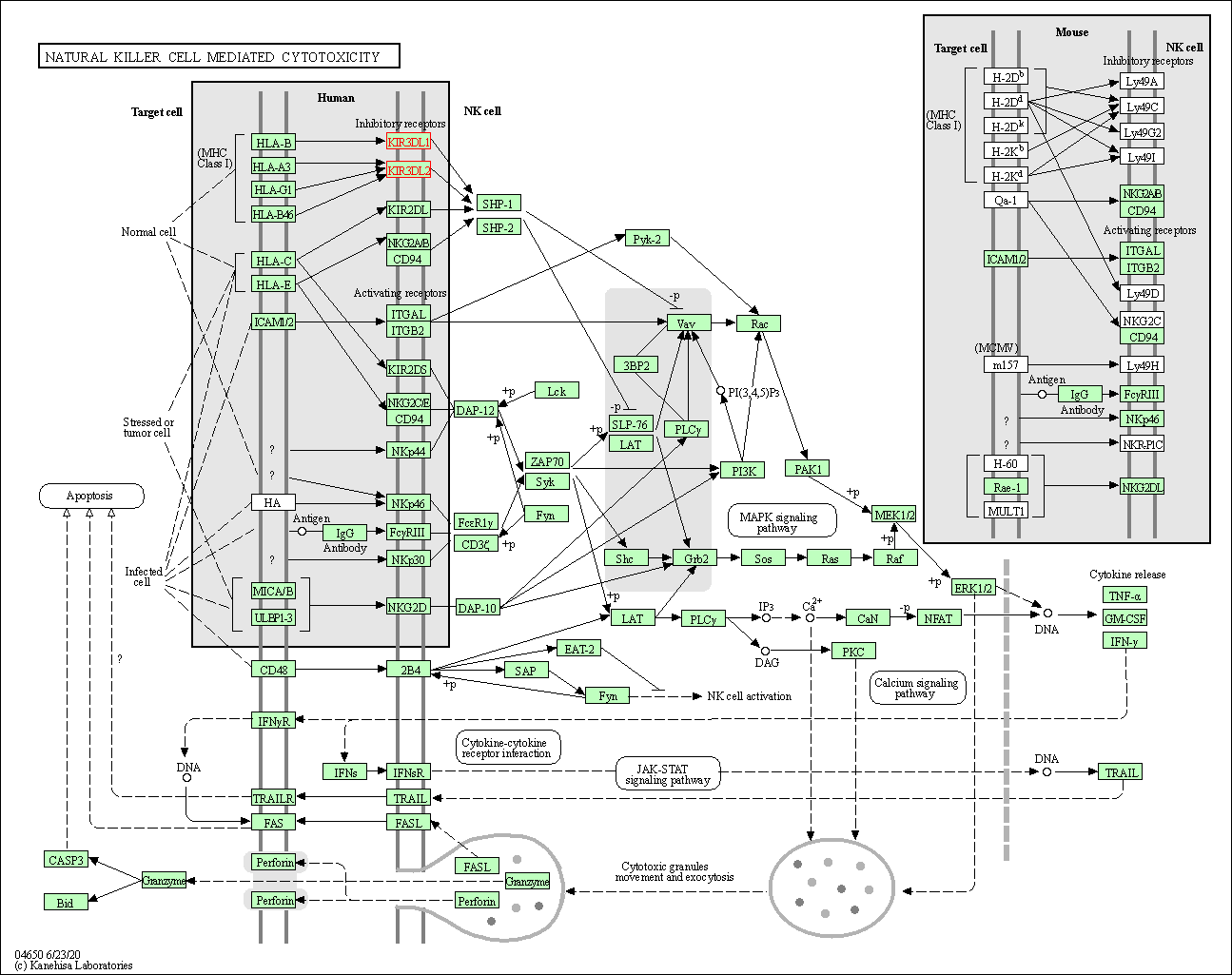Target Information
| Target General Information | Top | |||||
|---|---|---|---|---|---|---|
| Target ID |
T28217
(Former ID: TTDI02397)
|
|||||
| Target Name |
MHC class I NK cell receptor 3DL2 (CD158k)
|
|||||
| Synonyms |
p70 natural killer cell receptor clone CL5; p70 NK receptor CL5; Natural killerassociated transcript 4; NKAT4; KIR3DL2; CD158k; CD158 antigenlike family member K
Click to Show/Hide
|
|||||
| Gene Name |
KIR3DL2
|
|||||
| Target Type |
Clinical trial target
|
[1] | ||||
| Disease | [+] 1 Target-related Diseases | + | ||||
| 1 | Mature T-cell lymphoma [ICD-11: 2A90] | |||||
| Function |
Receptor on natural killer (NK) cells for HLA-A alleles. Inhibits the activity of NK cells thus preventing cell lysis.
Click to Show/Hide
|
|||||
| BioChemical Class |
Immunoglobulin
|
|||||
| UniProt ID | ||||||
| Sequence |
MSLTVVSMACVGFFLLQGAWPLMGGQDKPFLSARPSTVVPRGGHVALQCHYRRGFNNFML
YKEDRSHVPIFHGRIFQESFIMGPVTPAHAGTYRCRGSRPHSLTGWSAPSNPLVIMVTGN HRKPSLLAHPGPLLKSGETVILQCWSDVMFEHFFLHREGISEDPSRLVGQIHDGVSKANF SIGPLMPVLAGTYRCYGSVPHSPYQLSAPSDPLDIVITGLYEKPSLSAQPGPTVQAGENV TLSCSSWSSYDIYHLSREGEAHERRLRAVPKVNRTFQADFPLGPATHGGTYRCFGSFRAL PCVWSNSSDPLLVSVTGNPSSSWPSPTEPSSKSGICRHLHVLIGTSVVIFLFILLLFFLL YRWCSNKKNAAVMDQEPAGDRTVNRQDSDEQDPQEVTYAQLDHCVFIQRKISRPSQRPKT PLTDTSVYTELPNAEPRSKVVSCPRAPQSGLEGVF Click to Show/Hide
|
|||||
| 3D Structure | Click to Show 3D Structure of This Target | AlphaFold | ||||
| Drugs and Modes of Action | Top | |||||
|---|---|---|---|---|---|---|
| Clinical Trial Drug(s) | [+] 1 Clinical Trial Drugs | + | ||||
| 1 | IPH4102 | Drug Info | Phase 2 | T-cell lymphoma | [2] | |
| Mode of Action | [+] 1 Modes of Action | + | ||||
| Antagonist | [+] 1 Antagonist drugs | + | ||||
| 1 | IPH4102 | Drug Info | [1], [3] | |||
| Cell-based Target Expression Variations | Top | |||||
|---|---|---|---|---|---|---|
| Cell-based Target Expression Variations | ||||||
| Different Human System Profiles of Target | Top |
|---|---|
|
Human Similarity Proteins
of target is determined by comparing the sequence similarity of all human proteins with the target based on BLAST. The similarity proteins for a target are defined as the proteins with E-value < 0.005 and outside the protein families of the target.
A target that has fewer human similarity proteins outside its family is commonly regarded to possess a greater capacity to avoid undesired interactions and thus increase the possibility of finding successful drugs
(Brief Bioinform, 21: 649-662, 2020).
Human Pathway Affiliation
of target is determined by the life-essential pathways provided on KEGG database. The target-affiliated pathways were defined based on the following two criteria (a) the pathways of the studied target should be life-essential for both healthy individuals and patients, and (b) the studied target should occupy an upstream position in the pathways and therefore had the ability to regulate biological function.
Targets involved in a fewer pathways have greater likelihood to be successfully developed, while those associated with more human pathways increase the chance of undesirable interferences with other human processes
(Pharmacol Rev, 58: 259-279, 2006).
Biological Network Descriptors
of target is determined based on a human protein-protein interactions (PPI) network consisting of 9,309 proteins and 52,713 PPIs, which were with a high confidence score of ≥ 0.95 collected from STRING database.
The network properties of targets based on protein-protein interactions (PPIs) have been widely adopted for the assessment of target’s druggability. Proteins with high node degree tend to have a high impact on network function through multiple interactions, while proteins with high betweenness centrality are regarded to be central for communication in interaction networks and regulate the flow of signaling information
(Front Pharmacol, 9, 1245, 2018;
Curr Opin Struct Biol. 44:134-142, 2017).
Human Similarity Proteins
Human Pathway Affiliation
Biological Network Descriptors
|
|
| KEGG Pathway | Pathway ID | Affiliated Target | Pathway Map |
|---|---|---|---|
| Antigen processing and presentation | hsa04612 | Affiliated Target |

|
| Class: Organismal Systems => Immune system | Pathway Hierarchy | ||
| Natural killer cell mediated cytotoxicity | hsa04650 | Affiliated Target |

|
| Class: Organismal Systems => Immune system | Pathway Hierarchy | ||
| Degree | 4 | Degree centrality | 4.30E-04 | Betweenness centrality | 3.30E-09 |
|---|---|---|---|---|---|
| Closeness centrality | 1.70E-01 | Radiality | 1.27E+01 | Clustering coefficient | 8.33E-01 |
| Neighborhood connectivity | 1.48E+01 | Topological coefficient | 5.46E-01 | Eccentricity | 13 |
| Download | Click to Download the Full PPI Network of This Target | ||||
| References | Top | |||||
|---|---|---|---|---|---|---|
| REF 1 | Clinical pipeline report, company report or official report of the Pharmaceutical Research and Manufacturers of America (PhRMA) | |||||
| REF 2 | ClinicalTrials.gov (NCT03902184) IPH4102 Alone or in Combination With Chemotherapy in Patients With Advanced T Cell Lymphoma (TELLOMAK). U.S. National Institutes of Health. | |||||
| REF 3 | Clinical pipeline report, company report or official report of the Pharmaceutical Research and Manufacturers of America (PhRMA) | |||||
If You Find Any Error in Data or Bug in Web Service, Please Kindly Report It to Dr. Zhou and Dr. Zhang.

